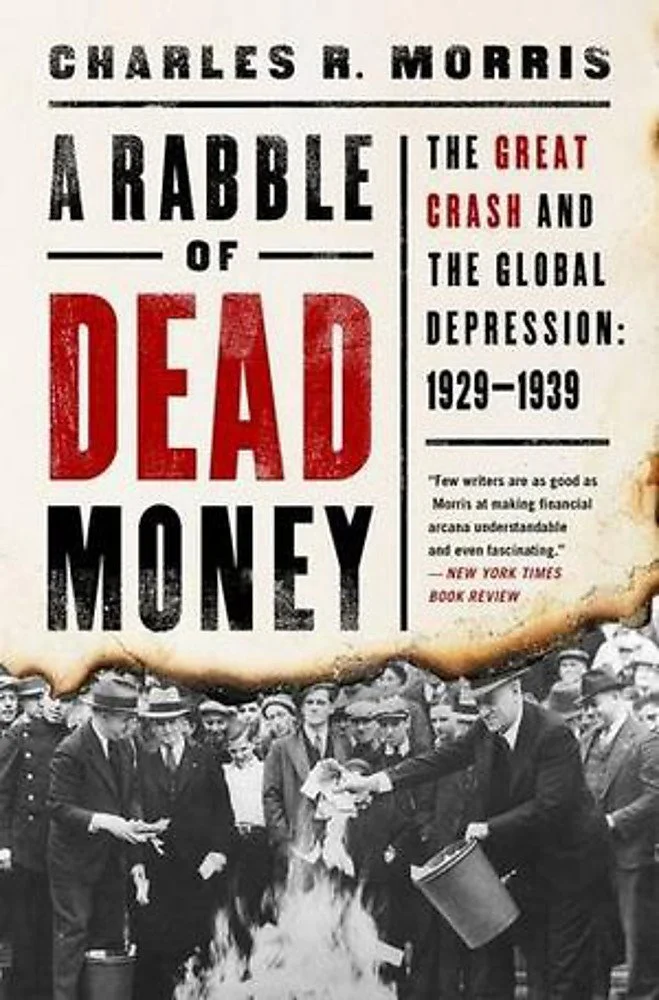Book Review: A Rabble of Dead Money
/A Rabble of Dead Money:The Great Crash and the Global Depression: 1929-1939
by Charles R. Morris
Public Affairs, 2017
Lawyer and former banker Charles Morris's 2008 book, The Trillion Dollar Meltdown (later dolefully re-issued as The Two Trillion Dollar Meltdown), anatomized with sometimes eerie prescience the causes and international scope of 2008's subprime lending crisis and the so-called Great Recession it provoked. All throughout that earlier book, Morris succeeds in putting human faces on the impersonal market forces driving people to devour each other, wreck their economies, and very nearly lay waste to the industrialized world. In his new book, A Rabble of Dead Money: The Great Crash and the Global Depression: 1929-1939, he turns from the worst financial meltdown of the 21st century (so far) to the worst financial meltdown of the 20th century, bringing to that much bigger subject the same qualities that made the earlier book so valuable and enjoyable.
He writes a wide-ranging story, since the Great Depression rumbled across almost the entire world, triggered by postwar overconfidence, egged on and manipulated by con men and opportunists, broadened and deepened by international rivalries, and usually worsened by the very efforts made to alleviate it. But although Morris does an excellent job of providing his readers an accurate look at the broad canvas on which the disaster unfolded, he's always at his best when writing about the home front, particularly a 1920s America awash in new money – and a 1920s rural America suddenly tempted by dozens of new ways to spend that money:
On top of the cruel financial pressures, working-class people were besieged with new ways to spend money. By 1924, Insull's company and other electrical conglomerates were steadily wiring up the towns and cities of the upper Midwest, and almost everyone in Muncie had electricity, with its spreading vistas of new things to buy. Electric irons and curling irons! Washing machines! Refrigerators! Toasters and waffle irons! Radios! For working-class women, who did not send the laundry out as their betters did, the washing machine was a miracle, much as the iron stove was for nineteenth-century farm women. No more boiling soiled clothes and scrubbing them on a washboard with raw-red hands. Working-class Muncie families frequently bought a washing machine before they had an indoor toilet.
This consistent reminder that the Great Depression shared the same motor as all other financial meltdowns – simple, bottomless human greed – is grim but salutary, and it gives the whole narrative an infuriating tension as things build to the day itself, the single day on which the fate of the world hinged:
But the malevolent genies of the market unleashed full-blooded havoc on Monday, the October 28 [sic], forever after known as “Black Monday.” Margin calls generated from the weekend accounts cleanup caused a wave of forced sales, lien filings, and angry face-offs between brokers and their clients. The Fed added $25 million in liquidity to the New York banks to ease the shock, but it couldn't stop the pullback. Just before the Crash, brokers' loans outstanding from New York City banks were at $6.6 billion. A month later they were at $3.6 billion, a level not seen since December 1927. The loss of $3 billion of market liquidity, equivalent to 3.5 percent of the New York Stock Exchange's total valuation, was enough by itself to sustain the market's dark downward momentum.
The comparatively gentle way those hard numbers are woven into the story is representative; Morris is extremely gifted at breaking down complex financial data into explanations than can be understood even by financial simpletons (like this reviewer, but also, in brutal fairness, like nine-tenths of the rest of Morris's audience, which is why financial meltdowns happen in the first place). The book has graphs and tables aplenty, simplified and designed to bring the full extent of his horror story into fine focus. And the combination of gripping storytelling and hard data makes A Rabble of Dead Money a very satisfying account of the money-cataclysm that gave birth to so much of the modern world, and to so many of the modern world's subsequent money-cataclysms. Readers bracing for the next one, which will arrive at some early point in 2019, will find this book both alarming and curiously reassuring; their grandparents survived the worst that could be done to them by malefactors of great wealth, and with a little luck, they will too.

